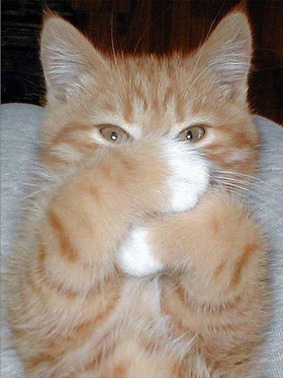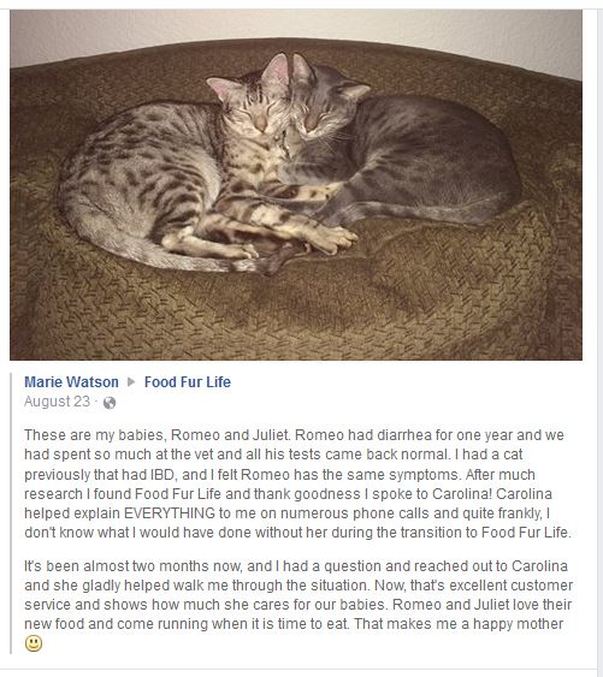|
Does your cat frustrate you with loving her food one day – and hating it the next? You might be surprised to learn that the problem could be the nutritional profile of the food you are offering her to eat, not the taste. Of course, cats experience nausea when ill. But a recent study indicates our apparently healthy kitties may have a sound reason for being finicky felines after all. “Balancing macronutrient intake in a mammalian carnivore: disentangling the influences of flavour and nutrition” found that – after a period of introduction to the food textures and flavors – aroma, taste and texture of food was not as important to cats as the macronutrient content of the food. “Macronutrient” content refers to the basic composition of the diet: protein, fats and carbohydrates. As we have discussed before, cats naturally consume a diet that is over 60% protein, about 20% fat, and has almost no carbohydrates (on a dry matter basis). As fat provides almost twice as many calories as protein, this equates to cats obtaining about 52% and 46% of their energy needs from protein and fat, respectively. (The diet they naturally consume provides just 2% of their energy from carbohydrates). In this study, cats were introduced to three basic new foods. These were wet foods with the texture of porridge. The flavors were fish, rabbit and orange. (!!!) Each food was initially formulated with a similar protein-to-fat ratio. The cats showed a strong preference for the fish-flavored food: rabbit was “neutral,” and orange flavored food disliked. No surprise there, right? The three different flavors of food were then formulated with three different ratios of protein and fat. On an energy basis, the three different food formulations were
When fed with those three different protein-to-fat options but offered just one flavor at a time, the protein-to-fat ratio of 70%/30% won as the favorite food, paws down. Then the cats were offered the varying protein-to-fat ratios with a mix of flavors such that the cats would have to eat orange flavored food in order to increase the protein in their diet. The cats ate a mix that averaged out to about 50% energy from protein and about 50% from fat, in line with the profile of their natural diet and the results of the 2011 study that eliminated taste preferences – even though that meant the cats had to choose to eat orange flavored food to achieve that mix of protein and fat. Adrien Hewson-Hughes, who led the study, told the Discovery News site, Seeker, “Cats initially selected food based on flavor preferences, but after 'learning' (due to prior exposure) about the nutritional composition of the foods, cats [subsequently] selected foods to reach a particular target balance of protein and fat regardless of added flavors.” Take a moment to absorb that. Cats chose a nutritional composition over taste and smell. As noted in the study discussion, “What is remarkable given the unusual nature and properties of the foods offered in these experiments — ‘porridge-like’ consistency, added flavours/aromas, different P : F [protein and fat] compositions and animal- or plant-derived protein sources — is the extent to which the balance and amounts of protein and fat intakes do converge... This indicates that macronutrient balancing is a powerful driver of food selection in cats and points to the ability to detect and respond to post-ingestive macronutrient signals that are distinct from sensory aspects contributing to the apparent palatability of foods.” (Our emphasis) In plain English, this means cats respond not just to taste, smell or texture – their bodies prompt them to eat what they need from a nutritional standpoint! It bears repeating: cats actually ate orange-flavored food (after learning it was, in fact, food) in order to consume a diet that (from the perspective of the ratio of meat and fat in the foods) resembles their evolutionary diet. As we have discussed before, cats are a metabolically inflexible hypercarnivore, and it really should come as no surprise that the diet they naturally strive to eat is what they need. It may be surprising to some that THEY know they need this. The mechanism responsible for this is not yet known. But what is most likely surprising to most (if not all) of us is the response of their bodies to diet is so strong, in order to get the nutrition they need, cats will eat food a food with a flavor they would most likely never – under normal circumstances – elect to eat on a taste/aroma basis. The qualifier there? They need to have been introduced to the foods and learn that they ARE food. Cats NEED to Be Introduced to New Foods If given the opportunity – and, importantly – when properly introduced to the food – cats will choose the diet that best suits their needs. As Dr. Hewson-Hughes told Discovery News, cats display an eating characteristic called neophobia. "This means they are unwilling to try a food that is new or different to their normal food, which may make them appear fussy." If we offer our kitty new food, especially a new food format such as wet from kibble or homemade from kibble or canned, we can’t expect them to like it right away – and we may meet with quite a bit of resistance. Cats are naturally cautious eaters and when a new food looks, smells, and feels so different, it is a part of their life-saving instinct to be distrustful. This is why we have several files dedicated to assisting with the process that results in a successful transition. Cats may instinctively know what they need – but most need to go through the learning process to understand that even healthy, tasty food IS food. Another interesting aspect of this study explains why cats, when they do take to a food if based just on taste, can so often appear to change their minds. This study indicates that every time you feed your cat, her body tells her whether she needs more or less of the nutrients in the food you’re offering her. If it has the same mid- or low-level of protein as what you were feeding; or if it has a similar carb content- she may well refuse the new food after a meal or two, despite liking the taste at first. So rather than commit to that new case of canned food, consider making your own cat food. A homemade balanced and complete cat food based on the prey model is what your cat needs – and your cat’s body knows it. With balanced and complete assurances (and the ability to use boneless raw or cooked meats) when you make your feline friend food with EZComplete fur Cats, you control the types AND cuts of meat you feed your cat. You control the mix of meat and fat. You control the texture (and temperature). If your cat doesn’t want ground food, you can feed it chunked. If your cat doesn't like gravy, add less water. Food Fur Life provides the tools you need to feed your cat the food her body wants and needs.
0 Comments
|
Archives
August 2021
Categories
All

|



 RSS Feed
RSS Feed